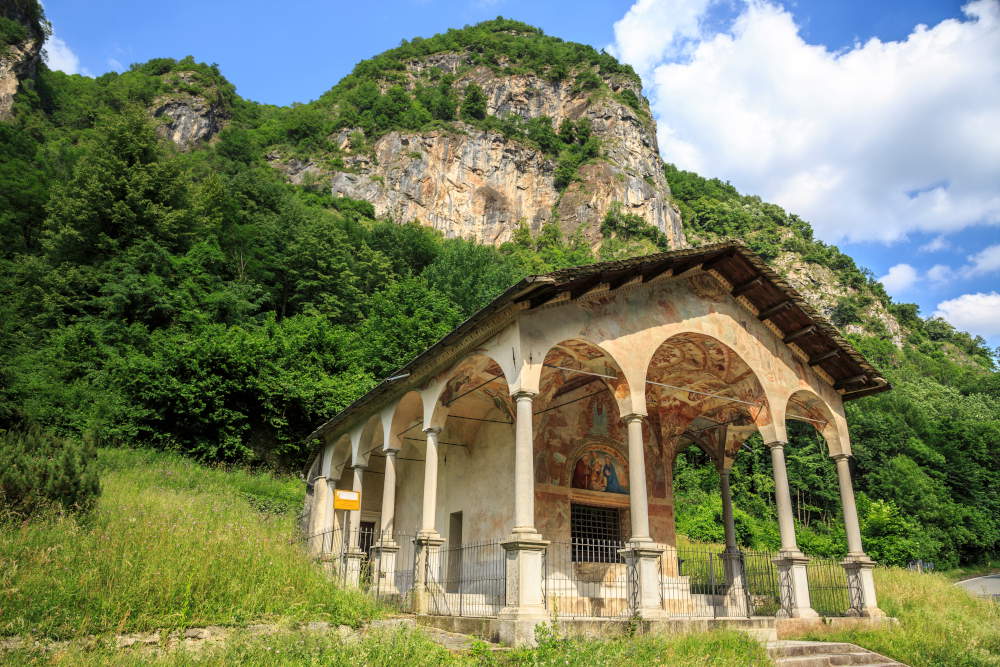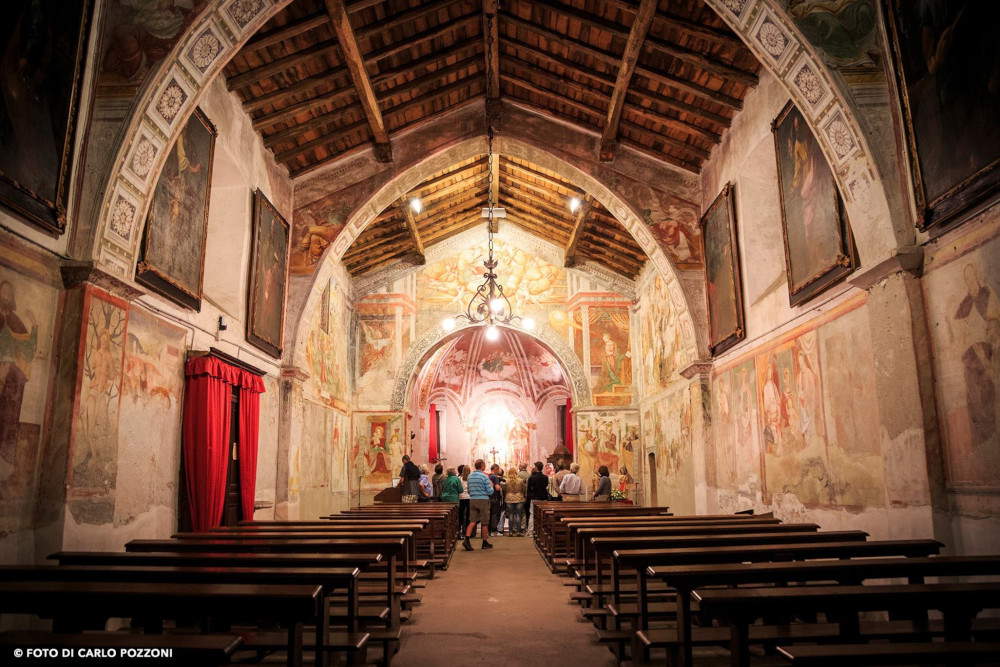When one thinks of Varallo, the small town in the province of Vercelli, in Valsesia, one unhesitatingly links it to Sacro Monte, but in reality it reveals quite a few surprises to its visitors: in addition to the aforementioned Sacro Monte and the Pinacoteca Civica located in the Palazzo dei Musei and considered one of the first public art collections in Piedmont, Varallo also offers churches and places of faith within which are kept true artistic masterpieces. We propose here an itinerary to discover Varallo’s churches and their treasures.
At the foot of the slope that leads from Piazza Gaudenzio Ferrari to Sacro Monte is the church of Santa Maria delle Grazie. Built between 1486 and 1493 at the behest of the Franciscan friar Bernardino Caimi, it houses inside the Parete Gaudenziana, among the most important works of Valsesia and its author: Gaudenzio Ferrari (Valduggia, c. 1477-80 - Milan, 1546), considered the greatest exponent of the sixteenth-century Piedmontese school of painting, whose art combined Leonardesque features of Lombardian painting with Renaissance influences, creating a personal style that made him famous. Gaudenzio Ferrari entirely frescoed a large wall (10.40 x 8 meters) of the church in 1513 with twenty-one depictions of episodes from the life and passion of Jesus, from the Annunciation to the Resurrection. It is considered a kind of anticipation to the asceticism of Sacro Monte, where the same artist decorated in fresco some chapels from 1513 to 1528 with episodes from the life of Christ. The frescoed partition was designed by St. Bernardine of Siena and divides the church into two areas: the area in front of the wall was also used in the past as a preaching hall where the faithful listened to homilies; the part behind it was used instead to celebrate Mass and the faithful could freely access it.

Varallo’s main square, dedicated to Victor Emmanuel II, is dominated by the Collegiate Church of San Gaudenzio, built on a rocky promontory accessed by climbing a large flight of steps. The building is surrounded by a loggia formed by twenty-eight arches supported by columns; the interior has a single nave with eight side chapels and a deep apse. Presumably the first nucleus dates from the early Middle Ages, perhaps built on a pagan place of worship: some historians have advanced this hypothesis to give an explanation for the choice of such an impervious site. However, from iconographic and documentary sources, we know that in the late sixteenth and early seventeenth centuries the building was enlarged to accommodate a larger number of worshippers. From the early eighteenth century the church was transformed at the behest of provost Benedetto Ludovico Giacobini. Inside it preserves, in the back wall of the apse basin, another work by Gaudenzio Ferrari: a polyptych made between 1517 and 1520 consisting of six panels depicting the Madonna and Child, St. Catherine and St. Joseph, St. Peter, St. Gaudentius, the Pietà, St. Mark and St. John the Baptist.

Not far from the center of Varallo, halfway between the hamlet of Roccapietra and Varallo, one encounters in a secluded position amidst the greenery the Church of Our Lady of Loreto: a small chapel with Renaissance forms that has an extensive decorative apparatus both outside and inside. Gaudenzio Ferrari also worked here, completing some decorations between 1514 and 1521. Such as the one visible above the entrance door that depicts a Nativity with Mary and Joseph and a musician angel caressing the Child. By contrast, theAssumption with angels and the twelve apostles that can be seen around the lunette are by Novarese painters. In the vaults of the loggia are then seen frescoes with scenes fromHell, Purgatory and Paradise and scenes from the Life of the Virgin. Inside the chapel, frescoed on the vault, are figures of Angels holding up angels, in close harmony with the style of the painter Gaudenzio Ferrari. On the walls are other scenes from the Life of the Virgin, painted in 1542 by Giulio Cesare Luini, while above the altar is another work by Ferrari: an Announcing Angel and a Virgin Announced; between them is a statue of a Madonna del Latte, in polychrome terracotta.

The church of San Marco is located at the entrance to Varallo. Already at the time of its foundation, perhaps in the last decades of the 14th century, the church was the city’s first place of welcome for pilgrims going up to Sacro Monte. Therefore, during the 16th century it was expanded both structurally and decoratively. It was home to the charitable institution known as the Charity of St. Mark’s Bread, whose existence is documented from 1581. The prior, who was responsible for the distribution of bread to the poor, baked throughout the month preceding the feast of St. Mark, led the institution. Because of its architectural structure, it gives the impression of a Romanesque complex, while the interior has a single nave and, above all, is completely covered with 15th- and 16th-century frescoes that give life to an open-page Gospel. Of the paintings that decorated the exterior of the church, only a large St. Christopher on the forepart wall is preserved, while the panels depicting episodes from the life of St. Mark have been detached and taken to the Pinacoteca Civica. On the walls of the nave hang six large canvases, depicting St. Peter, St. Paul and the four Evangelists made between 1682 and 1689 by Valsesian painter Pietro Francesco Gianoli and pupils from his workshop. On the right side of the nave, however, is the chapel of Our Lady of Perpetual Help.

The Basilica is considered thelast chapel of Sacro Monte. It was Bernardino Caimi who had the first church of Sacro Monte dedicated to the Assumption of the Virgin Mary built. In 1614, however, it became necessary to build a new church that could accommodate more pilgrims and worshippers: the new Basilica was therefore opened in the mid-eighteenth century. It houses the wooden sculpture of the Sleeping Virgin, attributed to Gaudenzio Ferrari; the entire interior was decorated in Baroque and Rococo style by artists such as Francesco Leva, Carlo Penna da Camasco, and Giovanni Antonio Orgiazzi the Elder. The facade was built only in 1896 in white marble, designed by architect Cerutti from Valpiana. In the choir can be seen the overhead chapel with theAssumption of Mary into Heavenly Paradise, the work of Dionigi Bussola and the Danedi brothers between 1665 and 1680, while the high altar and the"scurolo," or lower level of the Basilica, were made by Benedetto Alfieri in about 1740.

 |
| Five Varallo churches to visit with masterpieces by Gaudenzio Ferrari |
Warning: the translation into English of the original Italian article was created using automatic tools. We undertake to review all articles, but we do not guarantee the total absence of inaccuracies in the translation due to the program. You can find the original by clicking on the ITA button. If you find any mistake,please contact us.